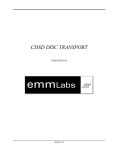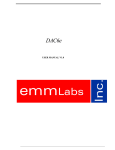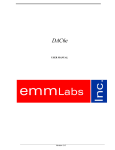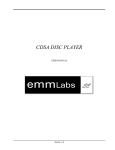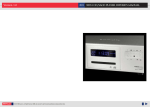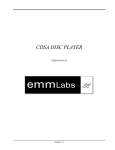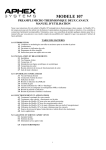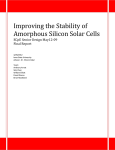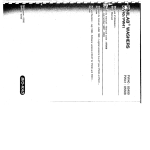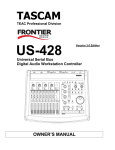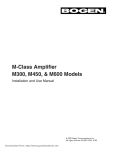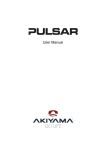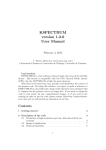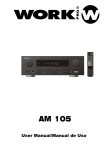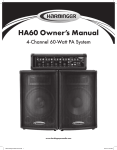Download Manual - EMM Labs
Transcript
DCC2 DIGITAL CONTROL CENTER USER MANUAL Version 1.8 DCC2 User Manual DCC2 Digital Control Center The DCC2 is a stereo D/A converter with built-in pre-amplifier that evolved from EMM Labs’s acclaimed converter and pre-amplifier systems that have been used worldwide in professional recording studios to master some of the finest recordings in both CD and SACD releases. The D/A section provides conversion from a wide variety of digital input formats to analog audio, and the pre-amp section provides 2 analog inputs and 1 analog output. There is an additional analog output that bypasses the pre-amp section. Features • 2-channel conversions: • from PCM (44.1kHz, 48kHz, 88.2kHz, 96kHz) to analog • from DSD to analog • Supported digital input formats: • AES/EBU (2 connectors and 1 connector) • SPDIF (Coax) • Optical TOSLink • PCM over optical ST glass (AES formatted) • RAW DSD • SDIF-3 (DSD) • EMM OptiLink • Analog Inputs • Balanced on XLR (switchable to be unbalanced) • Unbalanced on RCA • Analog outputs • Balanced on XLR for signals after pre-amp • Unbalanced on RCA for signals after pre-amp • Balanced on XLR for signals bypassing pre-amp • Unbalanced on RCA for signals bypassing pre-amp • Analog output impedances • 100Ω balanced, 50Ω unbalanced Note: XLR analog inputs and outputs are balanced with pin 2 hot, pin 3 cold and pin 1 ground. • Power supply • Power factor corrected • Factory set to 100V or 115V or 230V, 50/60Hz • Power consumption: 60W • Remote control: Infrared • Dimensions W x D x H: 435 x 400 x 92mm • Weight: 11kg 2 L R 2 BAL UNBAL R COAX RCA L TOS S/PDIF INPUTS ANALOG LINE INPUTS PUSH PUSH XLR PUSH PUSH AES/EBU INPUTS emm Labs ST R BNC R BNC DSD L IN ST ANALOG LINE OUTPUT L DSD INPUTS RCA PCM COAX OUT IN ST L REMOTE SYSTEM ANALOG PREAMP OUTPUT R OUT TOS ANALOG OUTPUT WORD CLOCK I/O AES INPUT SELECT BASE FS POLARITY DIGITAL BW 44.1 KHZ 48 KHZ INVERTED WIDE NARROW MUTE CLOCK CONTROL EXT CLOCK ANLG XLR LOCK RESET DCC2 2000 SERIAL MADE IN CANADA MODEL emmLabs DCC meitnerdesign 85 - 260 V 50 / 60 Hz 100 W MAX DCC2 User Manual 3 DCC2 User Manual Function Switches and Indicators Power The main power switch is on the back of the unit. The chrome power button on the front is a momentary switch that toggles the operation between power on and power save mode every time the user pushes it. During the power save mode the remote control and all front panel functions become inactive. Clock Control Section LOCK: This indicator is lit when the unit detects valid clock at the selected digital audio input. For normal operation with digital audio inputs this indicator has to be lit or else all audio outputs will be muted. For normal operation with analog audio inputs this indicator will stay off and all audio outputs are unmuted. EXT CLOCK: Selects external clock input when lit. The actual clock input is then determined by the selected digital input. This switch controls the “Master” and “Slave” operation as explained in more depth later in this manual. For Master operation this switch has to be turned off, and for Slave operation it has to be turned on. 44.1kHz / 48kHz: These buttons select the base frequency for the selected digital audio input. For instance, for all digital inputs with sample frequencies of 44.1kHz or 88.2kHz the switch 44.1kHz has to be selected, for all digital inputs with sample frequencies of 48kHz or 96kHz the switch 48kHz has to be selected. Analog Output Section POLARITY: When this switch is lit the polarity of all analog outputs is inverted. WIDE / NARROW: These switches are only active when a digital audio input source is selected and are inactive for analog input sources. When NARROW bandwidth is selected the analog outputs are lowpass filtered to limit the amount of signal content above 30kHz. The WIDE mode selects a much wider bandwidth and should be used in most cases. MUTE: When lit all outputs are muted. Pushing the button again unmutes the outputs. Analog, DSD and PCM Input Sections These 8 switches select the input source with associated clock. XLR: Balanced analog line input from the XLR connectors. Optionally this input can be configured for unbalanced inputs with a toggle switch on the rear panel besides the XLR connectors. RCA: Unbalanced analog line input from the RCA connectors. DSD - BNC: DSD digital input from the BNC connectors. Either RAW-DSD or SDIF-3 can be used (auto detection). DSD – ST: EMM OptiLink for direct connection to EMM Labs transport. 4 DCC2 User Manual PCM – AES/EBU: Selects PCM digital input from the XLR inputs. Sample rates up to 96kHz are supported. For sample rates of 88.2kHz and 96kHz there are 2 configurations that are commonly used: 1) one cable for 2 channels 2) 1 cable for each channel (total of 2 cables) If 1 cable is used it needs to be plugged into AES/EBU INPUT 1, and if 2 cables are used both inputs 1 and 2 have to be connected. In either case the DCC2 will automatically detect if the digital input is running at 44.1kHz or 88.2kHz (resp. at 48kHz or 96kHz) provided the correct base frequency is selected (44.1kHz resp. 48kHz). PCM – COAX: Selects PCM digital input from Coax (RCA) input. Sample rates up to 96kHz are supported. Make sure to select the base frequency of 44.1kHz for 44.1kHz and 88.2kHz sample rates, or select base frequency of 48kHz for 48kHz or 96kHz sample rates. PCM – TOS: Same as for PCM – COAX, but input is from optical TOSLink. PCM – ST: same as for PCM – COAX, but input is for optical ST glass. Volume Control The wheel on the front panel controls the volume on the analog pre-amp outputs. As the wheel is turned clockwise the volume increases and the displayed numbers increase, whereas when the wheel is turned anti-clockwise the volume decreases and the displayed numbers decrease. The displayed numbers range from 00 (volume is set to lowest) to 99 (volume is set to highest). Connecting Analog Outputs The DCC2 has 2 separate analog stereo outputs: ANALOG LINE OUTPUT This output bypasses the built-in pre-amplifier and volume control of the DCC2 and is always set to full level. Be careful and do NOT connect this output to your amplifier directly, but rather to your separate pre-amplifier. ANALOG PREAMP OUTPUT This output is from the internal pre-amplifier and is controlled by the volume control. This should be connected directly to your amplifier. However, be careful to first turn the volume down (low number in display). 5 DCC2 User Manual Basic Operations and Input Connections Memory after powerup and during operation After about 10 seconds after no button has been pushed and the volume has not been changed, the DCC2 memorizes its momentary setup in permanent memory for later retrieval after the next powerup. It will be recalled immediately after the unit is turned on. Each individual input selection will keep its last configuration and volume setting before powerdown. During normal operation each input selection will immediately memorize its configuration and volume setting so that switching between different sources with different configurations can be accomplished with a single button without having to adjust any other settings again. Note: Each input selection has its own volume setting that gets memorized when changing inputs. Wired remote control On the rear panel you can find a DIN 9-pin connector for serial remote control (see Appendix A for more details). Reset during operation Should there ever be a problem with the operation of the DCC2 you can push the Reset button on the rear panel to restart the internal software. This has the same effect as cycling the power off – on. , i.e. the DCC2 returns to the state that was last stored. Analog Input The pre-amp section of the DCC2 can be used with 2 analog inputs on the back of the unit: XLR or RCA as shown in below figure. PUSH PUSH UNBAL R XLR L BAL R RCA L ANALOG LINE INPUTS The XLR inputs can be configured as balanced or unbalanced (single ended) with the toggle switch on the back right next to the analog XLR input connectors. For unbalanced connections pin 2 of the XLR connector is assumed to be hot and pin 1 ground. 6 DCC2 User Manual Clock Master and Clock Slave Modes The DCC2 provides 2 basic ways for how to connect an audio source to it, such as a CD transport: clock master and clock slave modes. Master / slave is in reference to who provides the clock signal to the D/A conversion process and who receives an external clock as a guide signal to lock to. In clock master mode the DCC2 generates and provides the clock to the D/A conversion process and also to the CD transport. Of course, for this the CD transport has to be equipped with an external clock input. If no such connection is available then the only way to connect the transport to the DCC2 is in clock slave mode. The clock master mode will generally provide better sonic performance over the clock slave mode as clock jitter is minimized. In clock slave mode the transport provides the main clock and the DCC2 will use it as a reference to lock to. For best results you should operate the DCC2 in clock master mode whenever possible. The following paragraphs explain master and slave setups in detail for every individual digital source input of the DCC2. AES/EBU input In cases where the sample rate is either 44.1kHz or 48kHz there will be only 1 cable with XLR connectors for the audio data. Connector 1 on the back of the DCC2 has to be used. In cases where the sample rate is either 88.2kHz or 96kHz there are two possible topologies depending on how the source operates: • • 1 single cable for 2 channels 2 individual cables for 1 channel each Again, if only 1 cable is used it has to be plugged into connector 1 on the DCC2. For the 2 cable topology both connectors on the DCC2 have to be used. The DCC2 will automatically detect the correct topology and decode the audio data accordingly. For master clock operation a cable with BNC connectors needs to be connected according to below picture. For clock slave operation this cable is not necessary. 7 DCC2 User Manual Cable connections for AES/EBU input: DCC2 Digital Input Connectors AES/EBU INPUTS PUSH 1 PUSH S/PDIF INPUTS DSD INPUTS WORD CLOCK I/O 2 COAX TOS ST L BNC R IN IN OUT OUT DCC2 BNC clock cable (required only for clock master mode) AES/EBU cable with XLR connectors CD Deck BNC CLOCK IN AES/EBU DATA OUT CD/SACD Transport or other Source Front panel setup: Set this option for clock slave mode ! EXT LOCK CLOCK BASE FS 44.1 KHZ 48 KHZ POLARITY INVERTED CLOCK CONTROL DIGITAL BW WIDE NARROW MUTE ANALOG OUTPUT INPUT SELECT XLR RCA ANLG BNC ST DSD AES COAX TOS ST PCM 8 DCC2 User Manual EMM OptiLink This EMM Labs proprietary link is used for the best performance with a EMM Labs transport system. The cables used are standard ST glass (multimode). The link consists of 2 connections, one for data and one for clock. If the DCC2 is operated in clock master mode a third connection is necessary, which can be established with a ST glass optical cable as well to maintain the galvanic separation between transport and DCC2. Cable connections: DCC2 Digital Input Connectors PUSH 1 PUSH DSD INPUTS S/PDIF INPUTS AES/EBU INPUTS WORD CLOCK I/O 2 COAX TOS ST L BNC IN R OUT IN OUT OPTICAL CLOCK OUT OPTICAL CLOCK IN DCC2 3 Optical cables with ST connectors CD Deck ST OPTICAL DATA OUT CD/SACD Transport or other Source Front panel setup: Set this option for clock slave mode ! EXT LOCK CLOCK BASE FS 44.1 KHZ 48 KHZ POLARITY INVERTED CLOCK CONTROL DIGITAL BW WIDE NARROW MUTE ANALOG OUTPUT INPUT SELECT XLR RCA ANLG BNC ST DSD AES COAX TOS ST PCM 9 DCC2 User Manual Coax (SPDIF) input This link can operate for sample frequencies up to 96kHz. The DCC2 detects the correct frequency and adjusts automatically. Also with this link the DCC2 can be operated in either clock master or clock slave mode. Cable connections: DCC2 Digital Input Connectors AES/EBU INPUTS PUSH 1 PUSH S/PDIF INPUTS DSD INPUTS WORD CLOCK I/O 2 COAX TOS ST L BNC R IN IN OUT OUT DCC2 BNC clock cable (required only for clock master mode) Coax cable with RCA connectors CD Deck BNC CLOCK IN COAX DATA OUT CD/SACD Transport or other Source Front panel setup for clock master mode: Set this option for clock slave mode ! EXT LOCK CLOCK BASE FS 44.1 KHZ 48 KHZ POLARITY INVERTED CLOCK CONTROL DIGITAL BW WIDE NARROW MUTE ANALOG OUTPUT INPUT SELECT XLR RCA ANLG BNC ST DSD AES COAX TOS ST PCM 10 DCC2 User Manual TOSLink input Also with this link the DCC2 can be operated in either clock master or clock slave mode. Cable connections: DCC2 Digital Input Connectors AES/EBU INPUTS PUSH 1 PUSH S/PDIF INPUTS DSD INPUTS WORD CLOCK I/O 2 COAX TOS ST L BNC IN R OUT IN OUT DCC2 BNC clock cable (required only for clock master mode) Optical TOSLink cable CD Deck BNC CLOCK IN TOSLINK DATA OUT CD/SACD Transport or other Source Front panel setup for clock master mode: Set this option for clock slave mode ! EXT LOCK CLOCK BASE FS 44.1 KHZ 48 KHZ POLARITY INVERTED CLOCK CONTROL DIGITAL BW WIDE NARROW MUTE ANALOG OUTPUT INPUT SELECT XLR RCA ANLG BNC ST DSD AES COAX TOS ST PCM 11 DCC2 User Manual AES on ST glass input Also with this link the DCC2 can be operated in either clock master or clock slave mode. In master mode an optical cable can be used for the clock connection between DCC2 and your transport instead of a BNC cable. This will keep the DCC2 galvanically separated from the transport. But a BNC cable for the clock can also be used. Cable connections: DCC2 Digital Input Connectors AES/EBU INPUTS PUSH 1 PUSH DSD INPUTS S/PDIF INPUTS WORD CLOCK I/O 2 COAX TOS ST L BNC R IN OUT IN OUT DCC2 Optical clock cable (required only for clock master mode) Optical cable with ST connectors CD Deck OPTICAL CLOCK IN ST OPTICAL DATA OUT CD/SACD Transport or other Source Front panel setup for clock master mode: Set this option for clock slave mode ! EXT LOCK CLOCK BASE FS 44.1 KHZ 48 KHZ POLARITY INVERTED CLOCK CONTROL DIGITAL BW WIDE NARROW MUTE ANALOG OUTPUT INPUT SELECT XLR RCA ANLG BNC ST DSD AES COAX TOS ST PCM 12 DCC2 User Manual Infrared Remote Control The remote control included with the DCC2 provides many functions for the EMM Labs CDSD transport system as well. The functions that are relevant to the DCC2 specifically are highlighted in blue rectangles in the drawing on the right. DISPLAY – DCC2: This function toggles the front panel display on the DCC2 on and off. When off and pushing any button on the remote or front panel or adjusting the volume will turn the display on for about 3 seconds and then turn it off again automatically. ANALOG XLR: This selects the analog XLR input ANALOG RCA: This selects the analog RCA input DIGITAL: This selects the digital input that was last chosen via the front panel. VOLUME PHASE: MUTE: : DCC2 CDSD DISPLAY 2 3 4 5 6 7 8 9 0 REPEAT MODE PLAY PAUSE STOP XLR INPUT RCA DIGITAL ANALOG VOLUME PHASE MUTE This adjusts the volume setting up or down. When pressed for more than 3 seconds the volume will start scrolling automatically. Toggles the phase of the audio signal between normal and inverted. emm Labs Mutes all outputs 13 DCC2 User Manual Specification Output Line Level with 0dBfs signal on AES/EBU inut XLR balanced: RCA unbalanced: +12.55dBu / +10.35dBv / +3.3V +8.1dBu / +5.95dBv / +1.98V Pre-amp Output Level with 0dBfs signal in AES/EBU input Max. volume (99) XLR balanced: +18.4dBu / +6.47V RCA unbalanced: +13.95dBu / +3.866V Volume level 87 sets the pre-amp output level the same as the line level Warranty EMM Labs warrants the DCC2 product against defects in material and workmanship under normal use and service for a period of time specified by the product’s serial number from the date of first delivery to the owner. The warranty time period is 5 years limited to the original owner. EMM Labs will pay for return shipping charges back to the owner when the product is sent to EMM Labs within the first 90 days after purchase. Otherwise, owner will be responsible for all shipping charges to and from EMM Labs. For all warranty claims, a copy of the original invoice must accompany the product. Opening the product or modifying it in any way by the owner, including but not limited to cryogenic treatment, will void any warranty. Please contact EMM Labs ([email protected]) for RMA number and shipping instructions before shipping any product to EMM Labs. EMM Labs products are sold worldwide through authorized dealers with restricted territories. If any EMM Labs product is purchased from non-authorized dealers or from a dealer selling outside his / her authorized territory all warranties will be void. 14 DCC2 User Manual Appendix A: Serial Remote Control (RS-232) The DCC2 is equipped with a 9-pin RS-232 connector for system remote control via a serial cable (not provided by EMM Labs). The cable should be non-crossed for connections between a PC and the DCC2. The parameters and settings for this link are: • • • • • 19,200 baud 8 bits 1 stop bit no flow control no parity bit Commands to DCC2 All commands sent to the DCC2 consist of 3 ASCII characters followed by a <CR>. Repeating a <CR> will repeat the last command sent. This feature can be used to adjust the volume of the DCC2 over a wide range. Received commands are not stored in a stack and, therefore, need to be sent in intervals of at least 30ms to allow enough time for the DCC2 to execute a command before receiving the next one. Char 0 Char 1 Char 2 Char 0 <CR> >30ms mut wbw nbw pol 48k 44k clk pst tos cox aes dst bnc rca xlr don dof pon pof vup vdn Toggles mute on / off Select wide bandwidth for digital audio playback Select narrow bandwidth for digital audio playback Toggles polarity of all analog outputs inversed / normal Selects 48kHz base sample frequency Selects 44.1kHz base sample frequency Toggles external clock selection on / off Selects PCM input on ST glass connectors Selects PCM input on TOSLink connector Selects PCM input on coax connector Selects PCM input on AES/EBU connectors Selects DSD input on ST glass connectors Selects DSD input on BNC connectors Selects analog input on RCA connectors Selects analog input in XLR connectors Turns front panel display on Turns front panel display off (unit keeps operating) Turns power on from standby Turns DCC2 into standby operation Moves volume up by 1 step (repeat only <CR> to move multiple steps) Moves volume down by 1 step (repeat only <CR> to move multiple steps) 15 DCC2 User Manual Status info from DCC2 The DCC2 sends back 4 Bytes terminated with a <CR> whenever any status changes. Byte 0 Byte 0 Byte 1 Byte 2 Byte 3 Byte 4 bit 0 bit 1 bit 2 bit 3 bit 4 bit 5 bit 6 bit 7 bit 0 bit 1 bit 2 bit 3 bit 4 bit 5 bit 6 bit 7 Byte 1 Byte 2 Byte 3 <CR> Volume ones in ASCII Volume tens in ASCII Status of Analog XLR input (0 when selected) Status of Analog RCA input (0 when selected) Status of DSD input on BNC (0 when selected) Status of DSD input on ST glass (0 when selected) Status of PCM input on AES/EBU (0 when selected) Status of PCM input in Coax (0 when selected) Status of PCM input on TOSLink (0 when selected) Status of PCM input on ST glass input (0 when selected) 0 when clock is locked 0 when external clock is selected 0 when 44.1kHz selected as base sample frequency 0 when 48kHz selected as base sample frequency Status of polarity of analog ouputs (0 when inverted) Status of wide bandwidth selection (0 when selected) Status of mute (0 when muted) 1 when in Standby operation <CR> (x0D) 16
















